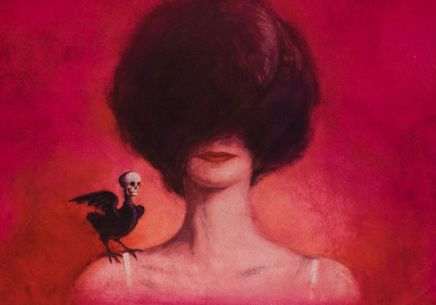
The exhibition of Franciszek Starowieyski’s movie posters was a recollection of the works of the artist, who died four years ago (in 2010) and used to be one of the most popular Polish painters. He was well known due to his peculiar artistic style, charm and the way he could easily establish contact with the audience. He was a member of the Polish School of Posters, whose works were presented by the MoMA during a dedicated exhibition.
Starowieyski was a total artist, whose private life was a part of an intentionally created myth, an artistic creation.
He was born in 1930 in Brakówka, in the Podkarpacie region. When he was 8 years old, Jan Cybis was his painting teacher. In 1949-1952 Starowieyski was studying at the Academy of Fine Arts in Kraków, then moved to the Academy of Fine Arts in Warszawa. In 1955 he created the painting Starość (Old Age), a diploma work under Michał Bylina as a supervisor, that was presented during a famous exhibition at the Arsenal. He created his first poster in 1956. It was a lithography on the uprising in Hungary, depicting a pigeon on a blue background, with a tear coming from its eye. The poster was copied in many journals across the world. In 1959 he created the Zbuntowana orkiestra poster (to the film Fanfare) inspired by the surrealism (presented on the exhibition).
The artist used to say that he would like to live 300 years earlier and since 1970 started to date his works as created three centuries earlier. He was fascinated with baroque, mannerism, Art Nouveau, surrealism, calligraphy, sex, death and grotesque. His pseudonym was Jan Byk. He used his physical appearance and landed gentry origins to create his image. He was a story-teller, he created myths, he was known for his controversial opinions and customs. For his whole life he was gathering his famous antiquities collection. He presented it to the audience in a way a Kunstkamera was presented before - as a collection of decorative, sometimes mysterious and rare objects.
In 1971 Andrzej Papuziński made a film Glory to the Byk on Starowieyski’s art. In 1974 Starowieyski went to New York thanks to the Kościuszko Foundation scholarship. A huge Manhattan studio allowed him to create large format paintings.
In 1980 Starowieyski developed a Teatr Rysowania (Theater of Drawing). He conducted almost 30 shows, during which he created huge paintings in front of his audience, supplemented with music and literary texts. In 1981 he played the role of painter Jacques-Louis David in Andrzej Wajda’s film Danton.
In 1986 the Museum of Modern Art in New York organized a one man show of his works. His poster Upiór z Morrisville (to the movie Borivoj Zeman) remains in MoMA’s collection, and is on display at the National Museum’s in Kraków exhibition.
In 1998 Starowieyski painted Divina Polonia rapta per Europa profana on a wall of the Polish Representation to the European Union’s office, that was ordered by Bronisław Geremek, then a Polish Minister of Foreign Affairs. This work caused many controversies and anecdotes. It was said that the personification of Europe sitting on an iron bull (according to the Greek mythology it should be a cow), crushing a Greek column, was supposed to be painted in an indecent straddle, but the artist had to change than.
In 1999, 10 years before his death, Starowieyski calculated that he created over 2000 paintings and drawings, 50 set designs for theaters and operas, as well as 300 posters.
Starowieyski created posters for movies, as well as theater and opera performances. He did not create political or commercial works. The focus on culture was a characteristic feature of the Polish School of Posters.
64 of Starowieyski’s movie posters will be presented by the National Museum in Kraków, mainly his early works from the 1950s and 1960s, a part of Konrad Pollesch’s collection of movie posters acquired by the National Museum in Kraków. The posters will be presented in the Gallery of Polish 20th-century Art, in the “Galeria Żywa” (”Live Gallery”) cycle presenting Polish 20th-century Art.
prepared by Magdalena Czubińska
Part of: Collection+ cycle, Colourism Room, Gallery of Polish 20th-century Art, National Museum in Kraków, Main Building, Al. 3 Maja 1
Co-financed by the Ministry of Culture and National Heritage
MNK The Main Building
al. 3 Maja 1 Colourism Room, Gallery of Polish 20th-century Art- Monday: closed
- Tuesday - Sunday: 10.00-18.00